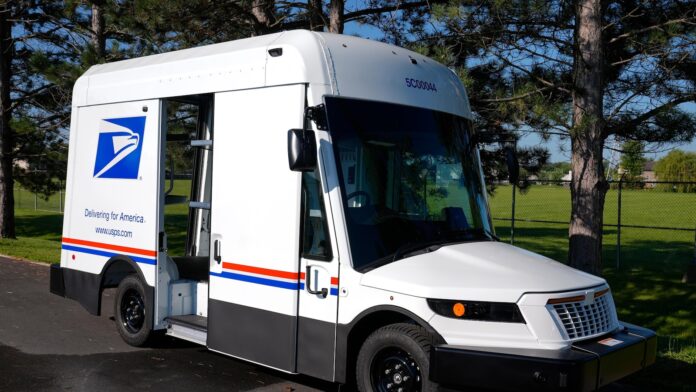ATHENS, Ga. — The Postal Service’s new delivery vehicles aren’t going to win any beauty contests. They’re long and clunky. Their windshields are huge. Their hoods look like duckbills. Their bumpers are huge.
“You can tell (the designers) didn’t have the look in mind,” said postman Avis Stonum.
Despite their odd appearance, the first handful of Next Generation Delivery Vehicles that hit Athens’ postal routes in August are drawing rave reviews from postal workers accustomed to old, cumbersome vehicles that lack modern safety features and are prone to breaking down or even catching fire.
Within a few years of the initial rollout, the fleet will expand to 60,000 vehicles, most of them electric, serving as the Postal Service’s primary delivery vehicles from Maine to Hawaii.
Once fully deployed, they become one of the most visible signs of the agency’s commitment. $40 Billion Transformation Over 10 Years led by Postmaster General Louis DeJoy, who is also renovating aging facilities, updating the processing and transportation network and making other changes.
The current postal vehicles—the Grumman Long Life Vehicle, dating from 1987—have lived up to their name, last longer than the expected lifespan of 25 yearsBut they are long overdue for replacement.
The Grummans are noisy and fuel-inefficient (9 mpg), and are expensive to maintain. They are blazing hot in the summer, with only an old-fashioned electric fan to circulate air. They have mirrors that, when perfectly aligned, allow the driver to see around the vehicle, but the mirrors constantly drift out of alignment. Alarmingly, nearly 100 of the vehicles caught fire last year, endangering both couriers and mail.
The new trucks are built with comfort, safety and usability in mind by Oshkosh Defense in South Carolina.
Even tall mailmen can stand upright and walk from front to back to pick up packages without bumping their heads. For safety, they have airbags, 360-degree cameras, blind-spot monitoring, collision sensors and anti-lock brakes — none of which are on the Grumman.
The new trucks also have a feature that became common in most cars more than 60 years ago: air conditioning. And that’s essential for drivers in the Deep South, the desert Southwest and other areas with scorching summers.
“I promise you, it felt like heaven was blowing in my face,” Stonum said of her first experience working in an air-conditioned truck.
Richard Burton, another driver, said he likes the larger cargo space, which can carry larger packages, and the fact that he can stand instead of crouching, which helps him avoid back pain. The old trucks also had a tendency to break down in traffic, he added.
Brian Renfroe, president of the National Letter Carriers Association, said union members are excited about the new vehicles, just as they were when the Grummans marked a leap forward from the previous vehicles, old-school Jeeps. He credited DeJoy with bringing a sense of urgency to get them into production.
“We’re excited to have them on the streets now,” Renfroe said.
The process started off slowly.
Environmentalists were outraged when DeJoy announced that 90% of first-generation vehicles would run on gasoline. Lawsuits were filed requiring the postal service to further electrify its fleet of more than 200,000 vehicles to reduce tailpipe emissions.
“Everyone went crazy,” DeJoy said.
The problem, DeJoy said, wasn’t that he didn’t want electric vehicles. The cost of the vehicles, compounded by the expense of installing thousands of charging stations and upgrading electric service, made them unaffordable at a time when the agency was reporting large operating deficits every quarter.
He found a way to further expand the number of electric vehicles when he met with President Joe Biden’s top environmental adviser, John Podesta, which led to a deal in which the the government has provided $3 billion to the postal service, part of which is intended for electric charging stations.
In December 2022, DeJoy announced the Postal Service would buy 106,000 vehicles through 2028. That included 60,000 next-gen vehicles, 45,000 of which would be electric models, along with 21,000 other electric vehicles. He pledged to go all-electric for new purchases starting in 2026.
“With the climate crisis looming, electrifying the U.S. government’s largest fleet of vehicles will deliver the progress we’ve been waiting for,” said Katherine García of the Sierra Club, who sued the Postal Service before its decision to increase purchases of electric vehicles.
Between electric vehicles, reduced tailpipe emissions from optimized postal routes and other changes, the agency expects Reduce CO2 emissions by 40% by 2030DeJoy said. The route changes will also save money.
This summer, the Postal Service’s environmental push came back into full swing when the White House honored the agency with a Presidential Federal Sustainability Award, ending “an interesting journey,” DeJoy said.
The honor is a sign of the agency’s ability to solve complex problems, whether they are operational, financial, technical, political or public policy in nature, he said.
“It comes from moving forward,” he said. “Keep moving.”
___
Sharp reported from Portland, Maine.



